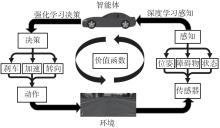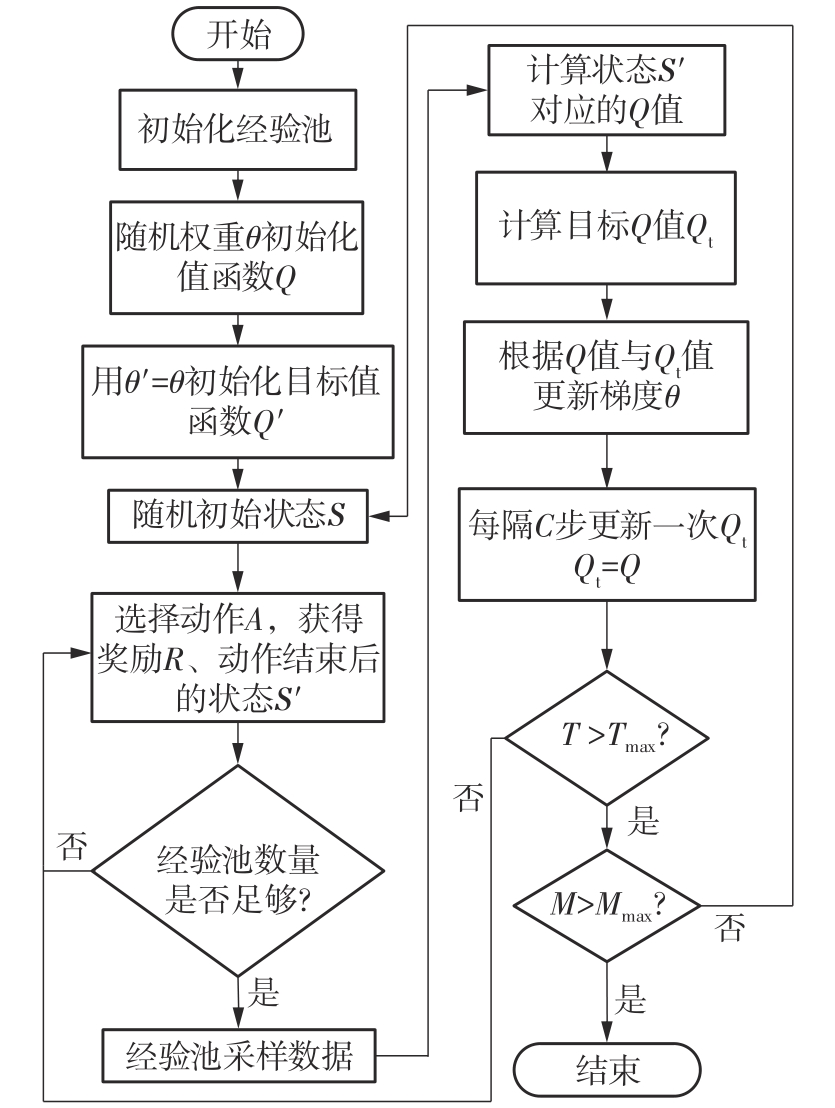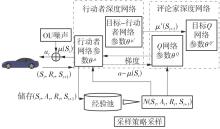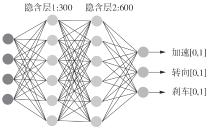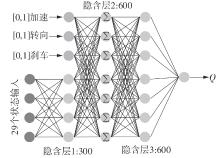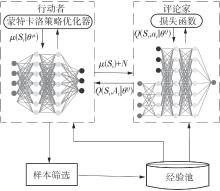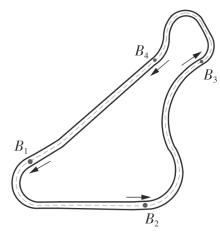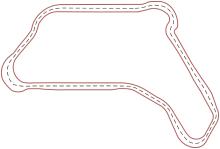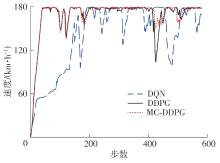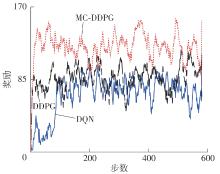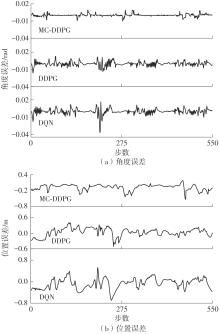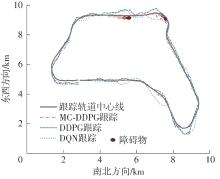Journal of South China University of Technology(Natural Science Edition) ›› 2023, Vol. 51 ›› Issue (11): 44-55.doi: 10.12141/j.issn.1000-565X.220747
Special Issue: 2023年电子、通信与自动控制
• Electronics, Communication & Automation Technology • Previous Articles Next Articles
Driverless Obstacle Avoidance and Tracking Control Based on Improved DDPG
LI Xinkai HU Xiaocheng MA Ping ZHANG Hongli
- School of Electrical Engineering,Xinjiang University,Urumqi 830017,Xinjiang,China
-
Received:2022-11-14Online:2023-11-25Published:2023-03-28 -
About author:李新凯(1991-),男,博士,讲师,主要从事智能控制、复杂非线性控制研究。E-mail:lxk@xju. edu. cn -
Supported by:the National Natural Science Foundation of China(62263030)
CLC Number:
Cite this article
LI Xinkai, HU Xiaocheng, MA Ping, et al.. Driverless Obstacle Avoidance and Tracking Control Based on Improved DDPG[J]. Journal of South China University of Technology(Natural Science Edition), 2023, 51(11): 44-55.
share this article
| 1 | JAN B, FARMAN H, KHAN M .Designing a smart transportation system:an internet of things and big data approach[J].IEEE Wireless Communications,2019,26(4):73-79. |
| 2 | 徐向阳,胡文浩,董红磊 .自动驾驶汽车测试场景构建关键技术综述[J].汽车工程,2021,43(4):610-619. |
| XU Xiangyang, HU Wenhao, DONG Honglei .Overview of key technologies for autonomous vehicle test scenario construction[J].Automotive Engineering,2021,43(4):610-619. | |
| 3 | 熊璐,杨兴,卓桂荣,等 .无人驾驶车辆的运动控制发展现状综述[J].机械工程学报,2020,56(10):127-143. |
| XIONG Lu, YANG Xing, ZHUO Guirong,et al .Overview on motion control of autonomous vehicles[J].Journal of Mechanical Engineering,2020,56(10):127-143. | |
| 4 | ZHANG X L, ZHANG W X, ZHAO Y Q .Personalized motion planning and tracking control for autonomous vehicles obstacle avoidance[J].IEEE Transactions on Vehicular Technology,2022,71(5):4733-4747. |
| 5 | 于向军,槐元辉,姚宗伟 .工程车辆无人驾驶关键技术[J].吉林大学学报(工学版),2021,51(4):1153-1168. |
| YU Xiang-jun, KUI Yuan-hui, YAO Zong-wei .Key technologies in autonomous vehicle for engineering[J].Journal of Jilin University(Engineering and Technology Edition),2021,51(4):1153-1168. | |
| 6 | GRUYER D, MAGNIER V, HAMDI K,et al .Perception information processing and modeling:critical stages for autonomous driving applications[J].Annual Reviews in Control,2017,41(10):323-341. |
| 7 | 张家旭,杨雄,施正堂,等 .汽车紧急换道避障的路径规划与跟踪控制[J].华南理工大学学报(自然科学版),2020,48(9):86-93,106. |
| ZHANG Jiaxu, YANG Xiong, SHI Zhengtang,et al .Path planning and tracking control for emergency lane change and obstacle avoidance of vehicles[J].Journal of South China University of Technology (Natural Science Edition),2020,48(9):86-93,106. | |
| 8 | WANG T, JIANG J F, LIN Y T,et al .Driver model for obstacle avoidance based on CarSim[J].Transactions of the Chinese Society of Agricultural Engineering,2010,26(5):159-163. |
| 9 | 樊晓平,李双艳,陈特放 .基于新人工势场函数的机器人动态避障规划[J].控制理论与应用,2005,22(5):703-707. |
| FAN Xiao-ping, LI Shuang-yan, CHEN Te-fang .Dynamic obstacle-avoiding path plan for robots based on a new artificial potential field function[J].Control Theory & Applications,2005,22(5):703-707. | |
| 10 | KATSUKI R, TASAKI T, WATANABE T .Graph search based local path planning with adaptive node sampling[C]∥ Proceedings of 2018 IEEE Intelligent Vehicles Symposium.Changshu:IEEE,2018:2084-2089. |
| 11 | WANG Hong-chao, ZHANG Wei-wei, WU Xun-cheng,et al .A double-layer nonlinear model predictive control based control algorithm for local trajectory planning for automated trucks under uncertain road adhesion coefficient conditions[J].Frontiers of Information Technology & Electronic Engineering,2020,21(7):1059-1074. |
| 12 | ZONG C G, JI Z J, YU Y,et al .Research on obstacle avoidance method for mobile robot based on multisensor information fusion[J].Sensors and Materials,2020,32(4):1159-1170. |
| 13 | YANG Z C, FENG Y T, ZHANG L X,et al .Obstacle avoidance control of underactuated robot based on neural network feedforward compensation[J].Measurement & Control Technology,2017,36(11):89-97. |
| 14 | 姚强强,田颖,王圣渊,等 .基于力驱动的智能汽车路径跟踪控制策略[J].华南理工大学学报(自然科学版),2022,50(2):33-41,57. |
| YAO Qiangqiang, TIAN Ying, WANG Shengyuan,et al .Research on path tracking control strategy of intelligent vehicles based on force drive[J].Journal of South China University of Technology (Natural Science Edition),2022,50(2):33-41,57. | |
| 15 | SALLAB A E, ABDOU M, PEROT E,et al .Deep reinforcement learning framework for autonomous driving[J].Electronic Imaging,2017,29(19):70-76. |
| 16 | 卢笑,竺一薇,阳牡花,等 .联合图像与单目深度特征的强化学习端到端自动驾驶决策方法[J].武汉大学学报(信息科学版),2021,46(12):1862-1871. |
| LU Xiao, ZHU Yiwei, YANG Muhua,et al .Reinforcement learning based end-to-end autonomous driving decision-making method by combining image and monocular depth features[J].Geomatics and Information Science of Wuhan University,2021,46(12):1862-1871. | |
| 17 | 张守武,王恒,陈鹏,等 .神经网络在无人驾驶车辆运动控制中的应用综述[J].工程科学学报,2022,44(2):235-243. |
| ZHANG Shou-wu, WANG Heng, CHEN Peng,et al .Overview of the application of neural networks in the motion control of unmanned vehicles[J].Chinese Journal of Engineering,2022,44(2):235-243. | |
| 18 | 董豪,杨静,李少波,等 .基于深度强化学习的机器人运动控制研究进展[J].控制与决策,2022,37(2):278-292. |
| DONG Hao, YANG Jing, LI Shao-bo,et al .Research progress of robot motion control based on deep reinforcement learning[J].Control and Decision,2022,37(2):278-292. | |
| 19 | WANG Y P, ZHENG K X, TIAN D X,et al .Asynchronous supervised learning pre-training methods for reinforcement learning autonomous driving models[J].Frontiers of Information Technology & Electronic Engineering,2021,22(5):673-687. |
| 20 | 吕帅,龚晓宇,张正昊,等 .结合进化算法的深度强化学习方法研究综述[J].计算机学报,2022,45(7):1478-1499. |
| Shuai LÜ, GONG Xiao-yu, ZHANG Zheng-hao,et al .Survey of deep reinforcement learning methods with evolutionary algorithms[J].Chinese Journal of Computers,2022,45(7):1478-1499. | |
| 21 | 张新钰,高洪波,赵建辉,等 .基于深度学习的自动驾驶技术综述[J].清华大学学报(自然科学版),2018,58(4):438-444. |
| ZHANG Xinyu, GAO Hongbo, ZHAO Jianhui,et al .Overview of deep learning intelligent driving methods [J].Journal of Tsinghua University (Science and Technology),2018,58(4):438-444. | |
| 22 | 陈红名,刘全,闫岩,等 .基于经验指导的深度确定性多行动者-评论家算法[J].计算机研究与发展,2019,56(8):1708-1720. |
| CHEN Hongming, LIU Quan, YAN Yan,et al .An experience-guided deep deterministic actor-critic algorithm with multi-actor[J].Journal of Computer Research and Development,2019,56(8):1708-1720. | |
| 23 | 陈亮,梁宸,张景异,等 .Actor-Critic框架下一种基于改进DDPG的多智能体强化学习算法[J].控制与决策,2021,36(1):75-82. |
| CHEN Liang, LIANG Chen, ZHANG Jing-yi,et al .A multi-intelligence reinforcement learning algorithm based on improved DDPG in the Actor-Critic framework[J].Control and Decision,2021,36(1):75-82. |
| [1] | LIN Yongjie, CHEN Ning, LU Kai. Vehicle Trajectory Tracking at Intersections Based on Millimeter Wave Radar Point Cloud [J]. Journal of South China University of Technology(Natural Science Edition), 2023, 51(10): 110-125. |
| [2] | ZHANG Jiaxu, WANG Chen, WANG Xinzhi, et al. Self-Driving Vehicle Speed Estimation Based on Adaptive Filter [J]. Journal of South China University of Technology (Natural Science Edition), 2021, 49(1): 74-81. |
| [3] | YANG Shun WU Jian JIANG Yuande WANG Guojun LIU Haizhen. Deep-Learning-Based Lane-Keeping Control Framework: From Virtuality to Reality [J]. Journal of South China University of Technology(Natural Science Edition), 2019, 47(9): 90-97. |
| [4] | Li Lin Ren Jun- lin Zou Yan- biao Lu Zhou. Trajectory Tracking of Mobile Robot Based on Immune Genetic Algorithm [J]. Journal of South China University of Technology (Natural Science Edition), 2013, 41(7): 13-18,25. |
| [5] | He Yue-bang Pei Hai-long Ye Xiang Zhang Qian. Trajectory Tracking Control of Unmanned Helicopters by Using Adaptive Dynamic Surface Approach [J]. Journal of South China University of Technology (Natural Science Edition), 2013, 41(5): 1-8. |
| [6] | He Yue-bang Pei Hai-long Zhao Yun-ji Li Jian-qiang. Flight Control Design of Unmanned Helicopter Based on Robust Integral Filtering Backstepping [J]. Journal of South China University of Technology (Natural Science Edition), 2013, 41(2): 30-36. |
| [7] | Zhai Jing-mei Kang Bo Tang Hui-hua. Adaptive Fuzzy Variable Structure Control Algorithm for Trajectory Tracking of Industrial Robots [J]. Journal of South China University of Technology(Natural Science Edition), 2012, 40(12): 12-16,23. |
| [8] | Xue Zhen-yu Fang Da-zhong Yuan Shi-qiang. Parameter Optimization Design of PSS Based on Functional Sensitivity [J]. Journal of South China University of Technology (Natural Science Edition), 2011, 39(8): 140-145. |
| [9] | Ye Jin-hua Li Di Ye Feng Lai Yi-zong. Adaptive Backstepping Sliding Mode Control of Uncertain Nonholonomic AGV [J]. Journal of South China University of Technology(Natural Science Edition), 2011, 39(12): 32-37,43. |
| [10] | Lin Pei-qun Xu Jian-min. Detection and Trajectory Tracking of Moving Vehicles in Complicated Traffic Scene [J]. Journal of South China University of Technology (Natural Science Edition), 2008, 36(6): 84-89. |
| [11] | Bian Jian-yong Xu Jian-min Hu Yue-ming. Trajectory Tracking Control of Intelligent Vehicle Based on Vision and Backstepping Method [J]. Journal of South China University of Technology (Natural Science Edition), 2008, 36(6): 90-94. |
| [12] | Zhao Yi-hong Zhu Jian-ying. Trajectory Tracking Control of Car-Like Mobile Robot Based on Integrated Steering [J]. Journal of South China University of Technology (Natural Science Edition), 2006, 34(11): 60-63. |
| [13] | Wu Xin-sheng Ren Hua-ying. An Optimized Fuzzy Control Approach to the Trajectory Tracking of Nonholonomic Mobile Robots [J]. Journal of South China University of Technology(Natural Science Edition), 2004, 32(3): 44-49. |
| Viewed | ||||||
|
Full text |
|
|||||
|
Abstract |
|
|||||


